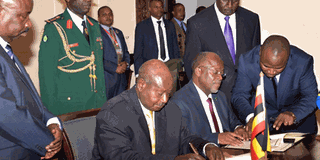Museveni, Magufuli to break ground for oil pipeline in Masaka

President Museveni and his Tanzanian counterpart, John Pombe Magufuli sign the East African crude oil pipe agreement in Dar es Salam on May 20, 2017. FILE PHOTO
What you need to know:
- Officials from both countries are currently evaluating possible financing options for the project.
- Actual construction is expected to start early next year and to be completed by 2020, if all goes according to plan, including timely securing of financing from the international lenders.
- The back-to-back feed study and environmental social impact assessment (ESIA) studies are expected to pave way to Final Investment Decision (FID) in the “first quarter of 2018.”
KAMPALA. Tanzanian President John Magufuli is expected in the country on Thursday on a three-day state visit during which, together with President Museveni, are scheduled to lay foundation stone to symbolise start of the construction of the proposed East African Crude Oil Pipeline (Eacop).
The 1,445-kilometre duct is planned to run from Hoima District in mid-western Uganda to Tanzania’s southern Tanga Port on the Indian Ocean coast.
The groundbreaking on Saturday was earlier planned to take place at Kabaale Village in Hoima but was moved about 200kms down south to Masaka to suit President Magufuli who was unwilling to travel to mid-western Uganda.
This, according to senior officials in both the ministries of Energy and Foreign Affairs, led the rescheduling of the groundbreaking ceremony from early October.
Officials said, they had proposed for Mr Magufuli to travel by a helicopter from Mutukula to Hoima but this he vehemently rejected.
The first foundation stone for the $3.5b (Shs12.6 trillion) project was laid by the two Heads of State at Chongoleani Marine Terminal at Tanga Port in August.
Officials familiar with the matter say, President Magufuli known for preaching frugality and cutting unwarranted government expenditure including redundant travels by officials in his government, is expected to travel by road to Mutukula at the Ugandan side.
Officials from both countries are currently evaluating possible financing options for the project. This newspaper understands that Tanzania and Uganda, backed by the French oil giant Total E&P, which supported the Tanga route, plan to raise 70 per cent of $3.5b capital expenditure.
The 30 per cent capital will be mustered through equity by the Joint Venture partners and national oil companies of the two countries; Tanzania Petroleum Development Corporation and Uganda National Oil Company.
For Uganda, the Uganda National Pipeline Company subsidiary will take the lead in securing funding for the pipeline.
Actual construction is expected to start early next year and to be completed by 2020, if all goes according to plan, including timely securing of financing from the international lenders.
Already, the technical, Front-End Engineering Designs (Feed) for the project, whose tender was awarded last December to US based Gulf Interstate Engineering and Danish consultancy, NIRAS Gruppen, are said to be complete “at the submission stage.”
The back-to-back feed study and environmental social impact assessment (ESIA) studies are expected to pave way to Final Investment Decision (FID) in the “first quarter of 2018.”




